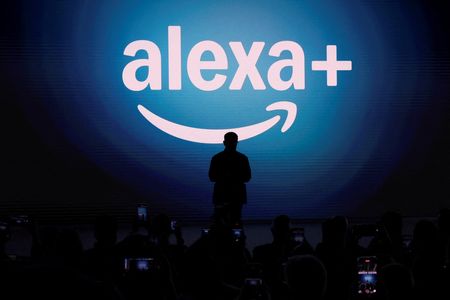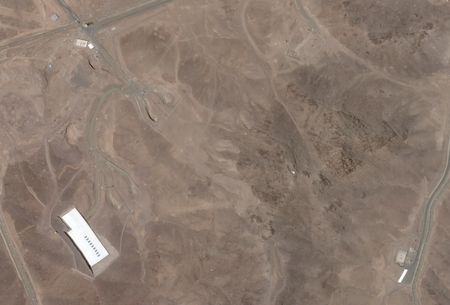By Greg Bensinger
SAN FRANCISCO (Reuters) -Alexa, where are your users?
More than six weeks after Amazon.com began rolling out the new Alexa+ generative artificial-intelligence-powered voice assistant to hundreds of thousands of people, there is scant evidence it is in regular customers’ hands.
The new service was meant to be a triumph for Amazon after several delays in revamping Alexa in the age of AI chatbots like ChatGPT. The company signaled its significance by bringing CEO Andy Jassy to a February press event in New York where it showcased Alexa+’s capabilities and promised customers would start getting invite access in late March.
“There seems to be no one who actually has it,” said Avi Greengart, lead analyst at Techsponential, who attended the Alexa+ announcement event. “This fits a pattern of a lot of companies announcing services or products when they are awfully close to being ready, but not quite – that last mile is a lot farther away than they anticipated,” he said.
In an ultimately unsuccessful effort to locate real-world users of Alexa+, Reuters searched dozens of news sites, YouTube, TikTok, X, BlueSky and Meta’s Instagram and Facebook, as well as Amazon’s Twitch and reviews of Echo voice-assistant devices on Amazon.com. Two who posted on Reddit claimed to have used the service, but did not provide Reuters with hard evidence and their identities could not be corroborated.
“Hundreds of thousands of customers now have access to Alexa+ — of course, some are employees and their families, but the overwhelming majority are customers that requested early access,” said an Amazon spokesperson. That is up from the approximately 100,000 users that Amazon reported on May 1.
Amazon did not say why there were no verifiable public reviews or reactions to the new service and declined to make available for an interview any active Alexa+ users. The company does not require nondisclosure agreements in exchange for Alexa+ access, a spokesperson said.
The rollout of Amazon AI-assisted Alexa+ is proceeding slowly and the service has struggled with speed in answering some questions or prompts, three sources familiar with the matter told Reuters. It also occasionally generates inaccurate or fabricated information, like other AI models, and is expensive to operate, the people said.
Accessed mainly through Amazon televisions and Echo devices, Alexa can set timers, answer search queries and tell the weather if a user requests it out loud. While Apple’s Siri voice assistant preceded the original Alexa by three years, it was the Amazon service that supercharged the acceptance of voice assistants.
The overhaul resulting in the generative AI-infused Alexa+ is meant to revitalize the decade-old service and help Amazon compete with chatbots from OpenAI, Meta and others. Amazon has plowed billions into developing Alexa since it was introduced in 2014, but it has been unprofitable and the vision of customers using it for voice-shopping never materialized.
Technology companies typically rely on a mix of analysts, product reviewers, social media influencers and reporters to help get the word out about their newest devices or services. Apple, considered a master of marketing, gives launch-event attendees limited access to its iPhones or laptops for initial reviews, followed shortly by lengthier scrutiny within days or weeks of announcement. Amazon itself gave reviewers time to test out its new color Kindle device at an event in October before making it available to buy just two weeks later.
In September 2023, Amazon showed off a prior iteration of the generative AI-infused Alexa and said customers would be getting an “early preview” of it within weeks. It never came.
Alexa+ will be able to respond to multiple prompts in sequence and even act as an “agent” on behalf of users by taking actions for them without their direct involvement. That contrasts with the current iteration, which generally handles only a single request at a time.
During Amazon’s first-quarter earnings call two weeks ago, Jassy said more than 100,000 people were already using the new voice service and that “people are really liking Alexa+ thus far.”
Americus Reed, a marketing professor at the University of Pennsylvania’s Wharton School, said that by leaving a large gap between product launch and general availability, Amazon was failing to build anticipation for Alexa+. “Just lean on your curated YouTube or TikTok advocates and tell them what to talk about,” he said. “Instead, this makes it look like they are worried about something.”
Techsponential’s Greengart said the February Alexa event could be seen as an early warning sign because attendees were not allowed to try the service themselves, instead being shuffled into breakout sessions where product managers ran through well-rehearsed routines and answered limited questions. Reuters, which attended the event, was also unable to try out the service.
By contrast, at Amazon’s 2014 launch for its Fire Phone, users could hold the device and try its features. The original Echo device, running the Alexa service, became available weeks after its announcement in November 2014 and users went public with their reactions that December.
The upgraded Alexa is designed to allow users to seek shopping advice such as vacation outfits and to receive aggregated news stories. As shown, it is meant to carry out more complicated requests, such as ordering food for delivery while also remembering a user’s dietary preferences.
To demonstrate Alexa+’s broad use, Amazon pointed to an April TechRadar story that cited an anonymous Reddit post from a user claiming to have tested the service.
The Reddit post has since been deleted.
(Reporting by Greg Bensinger in San FranciscoEditing by Kenneth Li, Anna Driver and Matthew Lewis)











